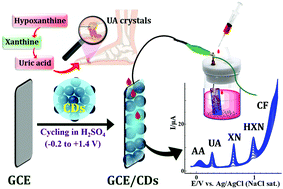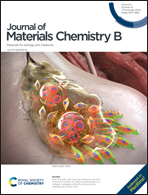Fabrication of low-cost sustainable electrocatalyst: a diagnostic tool for multifunctional disorders in human fluids†
Abstract
In purine metabolism, the xanthine oxidoreductase enzyme converts hypoxanthine (HXN) to xanthine (XN) and XN to uric acid (UA). This leads to the deposition of UA crystals in several parts of the body and the serum UA level might be associated with various multifunctional disorders. The dietary intake of caffeine (CF) and ascorbic acid (AA) decreases the UA level in the serum, which leads to cellular damage. Hence, it is highly needed to monitor the UA level in the presence of AA, XN, HXN, and CF and vice versa. Considering this sequence of complications, the present paper reports the fabrication of an electrochemical sensor using low-cost N-doped carbon dots (CDs) for the selective and simultaneous determination of UA in the presence of AA, XN, HXN, and CF at the physiological pH. The colloidal solution of CDs was prepared by the pyrolysis of asparagine and fabricated on a GC electrode by cycling the potential from −0.20 to +1.2 V in a solution containing CDs and 0.01 M H2SO4. Here, the surface –NH2 functionalities of CDs were used to make a thin film of CDs on the GC electrode. FT-IR spectroscopy confirmed the involvement of the –NH2 group in the formation of the CD film. HR-TEM analysis depicts that the formed CDs showed spherical particles with a size of 1.67 nm and SEM analysis exhibits the 89 nm CD film on the GC electrode surface. The fabricated CD film was successfully used for the sensitive and selective determination of UA. The determination of UA was achieved selectively in a mixture consisting of AA, XN, HXN, and CF with 50-fold high concentration. The CDs-film fabricated electrode has several benefits over the bare electrode: (i) well-resolved oxidation peaks for five analytes, (ii) boosted sensitivity, (iii) shifted oxidation as well as on-set potentials toward less positive potentials, and (iv) high stability. The practical utility of the present sensor was tested by simultaneously determining the multifactorial disorders-causing agents in human fluids. The electrocatalyst developed in the present study is sustainable and can be used for multiple analyses; besides, the electrochemical method used for the fabrication of the CD film is environmentally benign.



 Please wait while we load your content...
Please wait while we load your content...